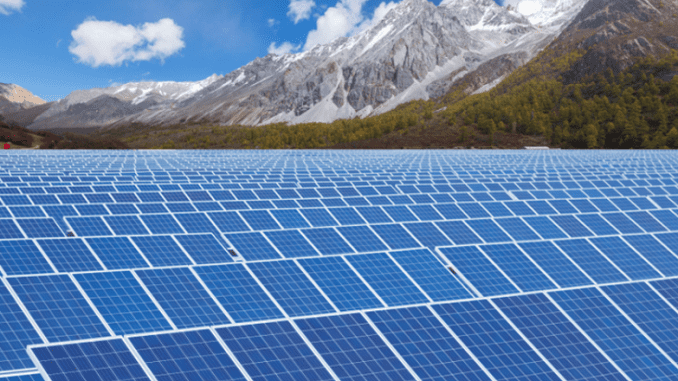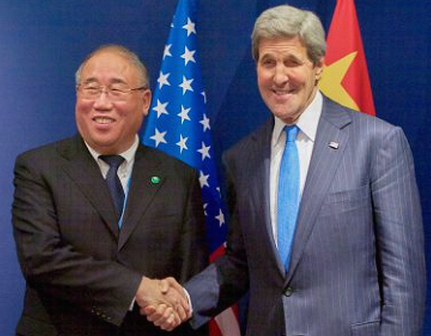
GLASGOW, Scotland, November 10, 2021 (ENS) – Recognizing the “seriousness and urgency of the climate crisis” the world’s two biggest carbon emitters, the United States and China, today issued a surprise joint declaration on upgrading their climate action. At the United Nations COP26 climate summit in Glasgow, the two sides promised to overlook their differences and work individually and together to limit climate change.
“The two sides are intent on seizing this critical moment to engage in expanded individual and combined efforts to accelerate the transition to a global net-zero economy,” their declaration states.
China’s special climate envoy Xie Zhenhua told reporters that both sides agreed to increase their efforts to cut emissions by tackling methane emissions and illegal deforestation, and by phasing out coal.
As the world’s two major economies, “We need to work actively to address climate change,” Xie said.
Xie said Tuesday that Beijing will “honor its word” and peak emissions before 2030, as he encouraged other nations to back up climate targets with detailed action plans. Last year, China’s President Xi Jinping committed China to achieving carbon neutrality by 2060.
Speaking at a separate news conference, U.S. Presidential Climate Envoy John Kerry said today, “The U.S. and China have no shortage of differences, but on climate, cooperation is the only way to get this job done.”
The two sides declared their intention to establish a “Working Group on Enhancing Climate Action in the 2020s,” which will meet regularly to address the climate crisis and advance the multilateral process. Kerry said that the group will focus on “concrete” measures.

These may be continued policy and technical exchanges, identification of programs and projects in areas of mutual interest, meetings of governmental and non-governmental experts, facilitating participation by local governments, enterprises, think tanks, academics, and other experts. The two sides agreed to exchange updates on their respective national efforts, consider the need for additional efforts, and review the implementation of their earlier Joint Statement and this Joint Declaration.
Both countries recognized the importance of the commitment made by developed countries to the goal of mobilizing jointly US$100 billion per year by 2020 and annually through 2025 to address the needs of developing countries, and they stressed the importance of meeting that goal as soon as possible.
The United States has set a goal to reach 100 percent carbon pollution-free electricity by 2035.
For its part, China will phase down coal consumption during the 15th Five Year Plan (2026-2030) and “make best efforts to accelerate this work.”
The two sides intend to cooperate on regulatory frameworks and environmental standards to reduce emissions of greenhouse gases in the 2020s.
They stated their intention to maximize the societal benefits of the clean energy transition; and promised policies to encourage decarbonization and electrification of end-use sectors and implement the circular economy with “green design and renewable resource utilization.”
Finally, the two sides committed to deployment and application of technology such as carbon capture and storage and direct air capture.
With respect to COP 26, both countries support “an ambitious, balanced, and inclusive outcome on mitigation, adaptation, and support.”
They declared that the COP26 outcome document must send a clear signal that the Parties to the Paris Agreement:
- – Are committed to tackling the climate crisis by strengthening implementation of the Paris Agreement, reflecting common but differentiated responsibilities and respective capabilities, in the light of different national circumstances;
- – Recall the Paris Agreement’s aim to hold the global average temperature increase to well below 2 degrees C and pursue efforts to limit it to 1.5 degrees C and are committed to pursuing such efforts, including by taking ambitious action during this critical decade to keep the above temperature limit within reach, including, as necessary, communicating or updating 2030 NDCs and long-term strategies;
- – Recognize the significance of adaptation in addressing the climate crisis, including further discussion on the global goal on adaptation and promoting its effective implementation, as well as the scaling up of financial and capacity-building support for adaptation in developing countries; and
- – Resolve to ensure that their collective and individual efforts are informed by “the best available science.”
The first draft of the conference’s communique was issued earlier today, and it appears that the rest of the week will bring the most intense negotiations to date.
COP 26 is scheduled to wrap on Friday, although many high-pressure conferences like this one sometimes hold over one day or even two.
Featured image: China currently has the largest solar capacity of any country in the world. (Photo by chinasong / Shutterstock)
© 2021, Environment News Service. All rights reserved. Content may be quoted only with proper attribution and a direct link to the original article. Full reproduction is prohibited.



